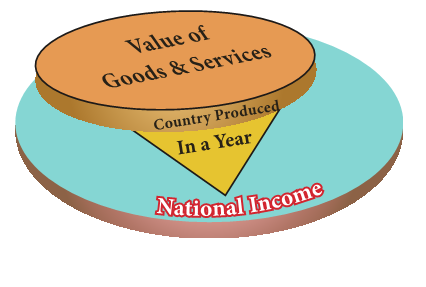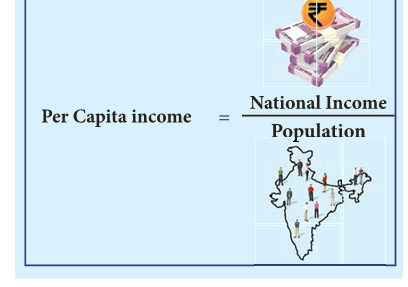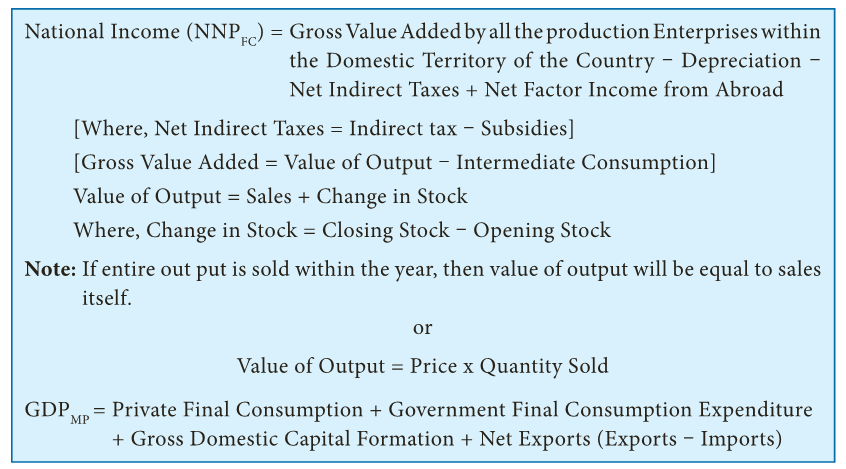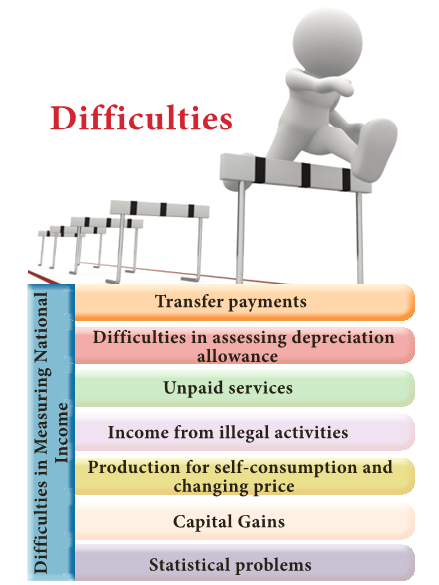National Income Notes 12th Economics
12th Economics Lesson 2 Notes in English
2. National Income
| “The concept of national income is an indispensable preparation for tackling the great issues of unemployment, inflation and growth”. – Samuelson |
Introduction
- National Income provides a comprehensive measure of the economic activities of a nation.
- It denotes the country’s purchasing power.
- The growth of an economy is measured by the rate at which its real national income grows over time.
- National income thus serves as an instrument of economic planning.
- Further, national income is one of the most significant macroeconomic variables.
- Thus, a clear understanding of the meaning, concepts, measurement and uses of national income is essential.
- Nobel laureate Simon Kuznets first introduced the concept of national income.
Meaning of National Income
- In common parlance, National Income means the total money value of all final goods and services produced in a country during a particular period of time (one year).

- Personal Income
- Disposable Income
- Per capita Income
- Real Income
- GDP deflator
Gross Domestic Product (GDP)
- GDP is the total market value of final goods and services produced within the country during a year.
- This is calculated at market prices and is known as GDP at market prices.
|
GDP by expenditure method at market prices = C + I + G + (X – M) |
- Where C – consumption goods;
- I – Investment goods;
- G – Government purchases;
- X – Exports;
- M – Imports (X – M) is net export which can be positive or negative.
a) Net Domestic Product (NDP)
- NDP is the value of net output of the economy during the year.
- Some of the country’s capital equipment wears out or becomes outdated each year during the production process. Thus
| Net Domestic Product = GDP – Depreciation. |
Gross National Product (GNP)
- GNP is the total measure of the flow of final goods and services at market value resulting from current production in a country during a year, including net
Definitions
- “The labour and capital of a country acting on its natural resources produce annually a certain net aggregate of commodities, material and immaterial including services of all kinds.
- This is the true net annual income or revenue of the country or national dividend”. –Alfred Marshall.
- “The net output of the commodities and services flowing during the year from the country’s productive system into the hands of the ultimate consumers or into net addition to the country’s stock of capital goods”. – Simon Kuznets.

GDP and its detractors.
- The welfare of a nation can scarcely be inferred from a measurement of national income as defined by the GDP… goals for more growth should specify of what and for what.
Basic concepts of national income
- The following are some of the concepts used in measuring national income.
- GDP
- GNP
- NNP
- NNP at factor cost
- Income from abroad. GNP includes five types of final goods and services :
- value of final consumer goods and services produced in a year to satisfy the immediate wants of the people which is referred to as consumption (C);
- gross private domestic investment in capital goods consisting of fixed capital formation, residential construction and inventories of finished and unfinished goods which is called as gross investment (I) ;
- goods and services produced or purchased by the government which is denoted by (G) ; and
- net exports of goods and services, i.e., the difference between value of exports and imports of goods and services, known as (X-M) ;
- Net factor incomes from abroad which refers to the difference between factor incomes (wage, interest, profits ) received from abroad by normal residents of India and factor incomes paid to the foreign residents for factor services rendered by them in the domestic territory in India (R-P);
- GNP at market prices means the gross value of final goods and services produced annually in a country plus net factor income from abroad (C + I + G + (X-M) + (R-P)).
| GNP at Market Prices = GDP at Market Prices + Net Factor income from Abroad. |
Net National Product (NNP) (at Market price)
- Net National Product refers to the value of the net output of the economy during the year.
- NNP is obtained by deducting the value of depreciation, or replacement allowance of the capital assets from the GNP.
- It is expressed as, NNP = GNP – depreciation allowance. (depreciation is also called as Capital Consumption Allowance)
NNP at Factor cost
- NNP refers to the market value of output.
- Whereas NNP at factor cost is the total of income payment made to factors of production.
- Thus from the money value of NNP at market price, we deduct the amount of indirect taxes and add subsidies to arrive at the net national income at factor cost.
| NNP at factor cost = NNP at Market prices – Indirect taxes + Subsidies. |
Personal Income
- Personal income is the total income received by the individuals of a country from all sources before payment of direct taxes in a year.
- Personal income is never equal to the national income, because the former includes the transfer payments whereas they are not included in national income.
- Personal income is derived from national income by deducting undistributed corporate profit, and employees’ contributions to social security schemes and adding transfer payment.
| Personal Income = National Income – (Social Security Contribution and undistributed corporate profits) + Transfer payments |
Disposable Income
- Disposable Income is also known as Disposable personal income.
- It is the individuals income after the payment of income tax.
- This is the amount available for households for consumption.
|
Disposable Income = Personal income – Direct Tax. |
- As the entire disposable income is not spent on consumption,
| Disposal income = consumption + saving. |
Per Capita Income
- The average income of a person of a country in a particular year is called Per Capita Income.
- Per capita income is obtained by dividing national income by population.

| Per Capita income =National Income divided by Population Population |
Real Income
- Nominal income is national income expressed in terms of a general price level of a particular year in other words, real income is the buying power of nominal income.
- National income is the final value of goods and services produced and expressed in terms of money at current prices.
- But it does not indicate the real state of the economy.
- The real income is derived as follows:

- P1 – Price index during current year;
- P0 – Price index during base year
GDP deflator
- GDP deflator is an index of price changes of goods and services included in GDP.
- It is a price index which is calculated by dividing the nominal GDP in a given year by the real GDP for the same year and multiplying it by 100.

Methods of Measuring National
- Income all goods and services produced in the country must be counted and converted against money value during a year.
- Thus, whatever is produced is either used for consumption or for saving.
- Thus, national output can be computed at any of three levels, viz., production, income and expenditure.
- Accordingly, there are three methods that are used to measure national income.
- Production or value added method
- Income method or factor earning method
- Expenditure method , And if these methods are done correctly, the following equation must hold
| Output = Income = Expenditure |
- This is because the three methods are circular in nature. It begins as production, through recruitments of factors of production, generating income and going as incomes to factors of production.
Product Method
- Product method measures the output of the country.
- It is also called inventory method.
- Under this method, the gross value of output from different sectors like agriculture, industry, trade and commerce, etc., is obtained for the entire economy during a year.
- The value obtained is actually the GNP at market prices.
- Care must be taken to avoid double counting.
- The value of the final product is derived by the summation of all the values added in the productive process.
- To avoid double counting, either the value of the final output should be taken into the estimate of GNP or the sum of values added should be taken.
- In India, the gross value of the farm output is obtained as follows :
- Total production of 64 agriculture commodities is estimated. The output of each crop is measured by multiplying the area sown by the average yield per hectare.
- The total output of each commodity is valued at market prices.
- The aggregate value of total output of these 64 commodities is taken to measure the gross value of agricultural output.
- The net value of the agricultural output is measured by making deductions for the cost of seed, manures and fertilisers, market charges, repairs and depreciation from the gross value.
| GDP – By Sum of Spending, Factor Incomes or Output | ||
| GDP (Expenditure) | GDP (Factor Incomes) | GDP (Value of Output) |
|
|
|
- Similarly, the gross values of the output of animal husbandry, forestry, fishery, mining and factory establishments are obtained by multiplying their estimates of total production with market prices.
- Net value of the output in these sectors is derived by making deductions for cost of materials used in the process of production and depreciation allowances, etc. from gross value of output.
- Net value of each sector measured in this way indicates the net contribution of the sector to the national income.
Precautions
- The product method is followed in the underdeveloped countries, but it is less reliable because the margin of error in this method is large.
- In India, this method is applied to agriculture, mining and manufacturing, including handicrafts.
- Double counting is to be avoided under value added method.
- Any commodity which is either raw material or intermediate good for the final production should not be included.
- For example, value of cotton enters value of yarn as cost, and value of yarn in cloth and that of cloth in garments.
- At every stage value added only should be calculated.
- The value of output used for self consumption should be counted while measuring national income.
- In the case of durable goods, sale and purchase of second hand goods (for example pre owned cars) should not be included.
Income Method (Factor Earning Method)
- This method approaches national income from the distribution side.
- Under this method, national income is calculated by adding up all the incomes generated in the course of producing national product.
Steps involved
- The enterprises are classified into various industrial groups.
- Factor incomes are grouped under labour income, capital income and mixed income.
- Labour income – Wages and salaries, fringe benefits, employer’s contribution to social security.
- Capital income – Profit, interest, dividend and royalty
- Mixed income – Farming, sole proprietorship and other professions.
- National income is calculated as domestic factor income plus net factor incomes from abroad. In short,
| Y = w + r + i + π + (R-P) |
- Where, w = wages,
- r = rent,
- i = interest,
- π = profits,
- R = Exports and
- P = Imports
- This method is adopted for estimating the contributions of the remaining sectors, viz., small enterprises, banking and insurance, commerce and transport, professions, liberal arts and domestic service, public authorities, house property and foreign sector transaction.
- Data on income from abroad (the rest of the world sector or foreign sector) are obtained from the account of the balance of payments of the country.
Precautions
- While estimating national income through income method, the following precautions should be taken.
Items not to be included
- Transfer payments are not to be included in estimation of national income as these payments are not received for any services provided in the current year such as pension, social insurance etc.
- The receipts from the sale of second hand goods should not be treated as part of national income as they do not create new flow of goods or services in the current year.
- Windfall gains such as lotteries are also not to be included as they do not represent receipts from any current productive activity.
- Corporate profit tax should not be separately included as it has been already included as a part of company profit.
Items to be included
- Imputed value of rent for self occupied houses or offices is to be included.
- Imputed value of services provided by owners of production units (family labour) is to be included.
The Expenditure Method (Outlay method)
- Under this method, the total expenditure incurred by the society in a particular year is added together.
- To calculate the expenditure of a society, it includes personal consumption expenditure, net domestic investment, government expenditure on consumption as well as capital goods and net exports. Symbolically,
| GNP = C + I + G + (X-M) |
- Where, C – Private consumption expenditure
- I – Private Investment Expenditure
- G – Government expenditure
- X-M = Net exports
Precautions
- Second hand goods: The expenditure made on second hand goods should not be included.
- Purchase of shares and bonds: Expenditures on purchase of old shares and bonds in the secondary market should not be included.
- Transfer payments: Expenditures towards payment incurred by the government like old age pension should not be included.
- Expenditure on intermediate goods: Expenditure on seeds and fertilizers by farmers, cotton and yarn by textile industries are not to be included to avoid double counting. That is only expenditure on final products are to be included.
Factor cost (FC)
- There are a number of inputs that are included into a production process when producing goods and services.
- These inputs are commonly known as factors of production and include things such as land, labour, capital and entrepreneurship.
- Producers of goods and services incur a cost for using these factors of production. These costs are ultimately added onto the price of the product.
- The factor cost refers to the cost of production that is incurred by a firm when producing goods and services.
- Examples of such production costs include the cost of renting machines, purchasing machinery and land, paying salaries and wages, cost of obtaining capital, and the profit margins that are added by the entrepreneur.
- The factor cost does not include the taxes that are paid to the government since taxes are not directly involved in the production process and, therefore, are not part of the direct production cost.
- However, subsidies received are included in the factor cost as subsidies are direct inputs into the production.
Market price (MP)
- Once goods and services are produced they are sold in a market place at a set market price.
- The market price is the price that consumers will pay for the product when they purchase it from the sellers.
- Taxes charged by the government will be added onto the factor price while subsides provided will be reduced from the factor price to arrive at the market price.
- Taxes are added on because taxes are costs that increase the price, and subsidies are reduced because subsidies are already included in the factor cost, and cannot be double counted when market price is calculated.
| Thus, MP = FC + Indirect Taxes – Subsidies …… Equation (1) Or, |
| FC = MP – Indirect Taxes + Subsidies ……….. Equation (2) |
- National Income (NNP FC) = Gross Value Added by all the production Enterprises within the Domestic Territory of the Country – Depreciation – Net Indirect Taxes + Net Factor
- Income from Abroad [Where, Net Indirect Taxes = Indirect tax – Subsidies] [Gross Value Added = Value of Output – Intermediate Consumption] Value of Output = Sales + Change in Stock Where, Change in Stock = Closing Stock – Opening Stock
- Note: If entire output is sold within the year, then value of output will be equal to sales itself or Value of Output = Price x Quantity Sold GDP MP = Private Final Consumption + Government Final Consumption Expenditure + Gross Domestic Capital Formation + Net Exports (Exports – Imports)

Importance of National Income
- Analysis National income is of great importance for the economy of a country.
- Nowadays the national income is regarded as accounts of the economy, which are known as social accounts. It enables us
- To know the relative importance of the various sectors of the economy and their contribution towards national income; from the calculation of national income, we could find how income is produced, how it is distributed, how much is spent, saved or taxed.
- To formulate the national policies such as monetary policy, fiscal policy and other policies; the proper measures can be adopted to bring the economy to the right path with the help of collecting national income data.
- To formulate planning and evaluate plan progress; it is essential that the data pertaining to a country’s gross income, output, saving and consumption from different sources should be available for economic planning.
- To build economic models both in short – run and long – run.
- To make international comparison, inter – regional comparison and inter – temporal comparison of growth of the economy during different periods.
- To know a country’s per capita income which reflects the economic welfare of the country (Provided income is equally distributed)
- To know the distribution of income for various factors of production in the country.
- To arrive at many macro economic variables namely, Tax – GDP ratio, Current Account Deficit – GDP ratio, Fiscal Deficit – GDP ratio, Debt – GDP ratio etc.
Difficulties in Measuring National Income
- In India, a special conceptual problem is posed by the existence of a large, unorganised and non-monetised subsistence sector where the barter system still prevails for transacting goods and services.
- Here, a proper valuation of output is very difficult.

Transfer payments
- Government makes payments in the form of pensions, unemployment allowance, subsidies, etc.
- These are government expenditure.
- But they are not included in the national income.
- Because they are paid without adding anything to the production processes.
- During a year, Interest on national debt is also considered transfer payments because it is paid by the government to individuals and firms on their past savings without any productive work.
Difficulties in assessing depreciation allowance
- The deduction of depreciation allowances, accidental damages, repair and replacement charges from the national income is not an easy task.
- It requires high degree of judgment to assess the depreciation allowance and other charges.
Unpaid services
- A housewife renders a number of useful services like preparation of meals, serving, tailoring, mending, washing, cleaning, bringing up children, etc.
- She is not paid for them and her services are not directly included in national income.
- Such services performed by paid servants are included in national income.
- The reason for the exclusion of her services from national income is that the love and affection of a housewife in performing her domestic work cannot be measured in monetary terms.
- Similarly, there are a number of goods and services which are difficult to be assessed in money terms for the reason stated above, such as rendering services to their friends, painting, singing, dancing, etc.
Income from illegal activities
- Income earned through illegal activities like gambling, smuggling, illicit extraction of liquor, etc., is not included in national income.
- Such activities have value and satisfy the wants of the people but they are not considered as productive from the point of view of society.
Production for self-consumption and changing price
- Farmers keep a large portion of food and other goods produced on the farm for self consumption.
- The problem is whether that part of the produce which is not sold in the market can be included in national income or not.
- National income by product method is measured by the value of final goods and services at current market prices.
- But prices do not remain stable. They rise or fall.
- To solve this problem, economists calculate the real national income at a constant price level by the consumer price index.
Capital Gains
- The problem also arises with regard to capital gains.
- Capital gains arise when a capital asset such as a house, other property, stocks or shares, etc. is sold at higher price than was paid for it at the time of purchase.
- Capital gains are excluded from national income.
Statistical problems
- There are statistical problems, too. Great care is required to avoid double counting.
- Statistical data may not be perfectly reliable, when they are compiled from numerous sources.
- Skill and efficiency of the statistical staff and cooperation of people at large are also equally important in estimating national income.
- The following are the some of the statistical problems:
- Accurate and reliable data are not adequate, as farm output in the subsistence sector is not completely informed. In animal husbandry, there are no authentic production data available.
- Different languages, customs, etc., also create problems in computing estimates.
- People in India are indifferent to the official inquiries. They are in most cases non-cooperative also.
- Most of the statistical staff are untrained and inefficient.
- Therefore, national income estimates in our country are not very accurate or adequate.
- There is at least 10 per cent margin of error, i.e., national income is overestimated or underestimated by at least 10 per cent.
- That is why the GDP estimates for India varies from 2 trillion US dollar to 5 trillion US dollar.
National Income and Social Accounting
- National income is also being measured by the social accounting method. Under this method, the transactions among various sectors such as firms, households, government, etc., are recorded and their interrelationships traced.
- The social accounting framework is useful for economists as well as policy makers, because it represents the major economic flows and statistical relationships among various sectors of the economic system.
- It becomes possible to forecast the trends of economy more accurately.
Social Accounting and Sector
- Under this method, the economy is divided into several sectors.
- A sector is a group of individuals or institutions having common interrelated economic transactions.
- The economy is divided into the following sectors
- Firms,
- Households,
- Government,
- Rest of the world and
- Capital sector.
- “Firms” undertake productive activities. Thus, they are all organizations which employ the factors of production to produce goods and services.
- “Households” are consuming entities and represent the factors of production, who receive payment for services rendered by them to firms.
- Households consume the goods and services that are produced by the firms. Thus, firms make payment to households for their services.
- Households spend money incomes they received on the goods and services produced by the firms.
- This is a circular flow of money between these two groups.
- “The Government sector” refers to the economic transactions of public bodies at all levels, centre, state and local.
- In their work concerning social accounting, Edey and Peacock have defined government as a collective ‘person’ that purchases goods and services from firms.
- These purchases may be financed through taxation, public borrowings, or any other fiscal means.
- The main function of the government is to provide social goods like defence, public health, education, etc.
- This means satisfying the collective wants of society.
- However, public enterprises like Post Offices and railways are separated from the Government sector and included as “Firms”.
- “Rest of the world sector” relates to international economic transactions of the country.
- It contains income, export and import transactions, external loan transaction, and allied overseas investment income and payments.
- “Capital sector” refers to saving and investment activities.
- It includes the transactions of banks, insurance corporations, financial houses, and other agencies of the money market.
- These are not included under “Firms”. These agencies merely provide financial assistance to the firms’ activities.
- While assessing sectoral contribution to GDP, the economy is divided into three namely Primary, Secondary and Tertiary sectors.
National Income and Welfare
- National Income is considered as an indicator of the economic wellbeing of a country.
- The economic progress of countries is measured in terms of their GDP per capita and their annual growth rate.
- A country with a higher per capita income is supposed to enjoy greater economic welfare with a higher standard of living.
- But the rise in GDP or per capita income need not always promote economic welfare.
- The per capita income as an index of economic welfare suffers from limitations which are stated below:
- The economic welfare depends upon the composition of goods and services provided.
- The greater the proportion of capital goods over consumer goods, the improvement in economic welfare will be lesser.
- Similarly the production of luxuries is meant for rich classes only.
- Higher GDP with greater environmental hazards such as air, water and soil pollution will be little economic welfare.
- The production of war goods will show the increase in national output but not welfare.
- An increase in per capita income may be due to employment of women and children or forcing workers to work for long hours.
- But it will not promote economic welfare.
- Therefore the Physical Quality of Life Index (PQLI) is considered a better indicator of economic welfare.
- It includes standard of living, life expectancy at birth and literacy.
National Income & Erosion of national Wealth
- For achieving higher GDP, larger natural resources are being depleted or damaged.
- This means reduction of potential for future growth.
- Hence, it is suggested that while assessing national income, loss of natural resources should be subtracted from national income.
National income in terms of US$
- When Indian national income is expressed in terms of US$, the former looks very low.
- If Purchasing Power Parity (PPP) method is adopted India looks better.
Social and Environmental Cost
- While producing economic goods, many environmental and social bads are also generated.
- Hence, they also must be considered while enumerating National income.
MORE TO KNOW:
- The national income of a country describes the economic performance or production performance of a country.
- Economists, planners, government, businessmen and international agencies (IMF, World Bank, etc.,) use national income data and analyses them for various purposes.
- National income data help in measuring changes in the standard of living over time and also enable us to compare standard of living of different countries.
- Level of development of a country is also measured by using national income figures.